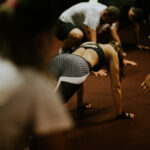7 Arm Exercises That Are Proven to Build Muscle Fast
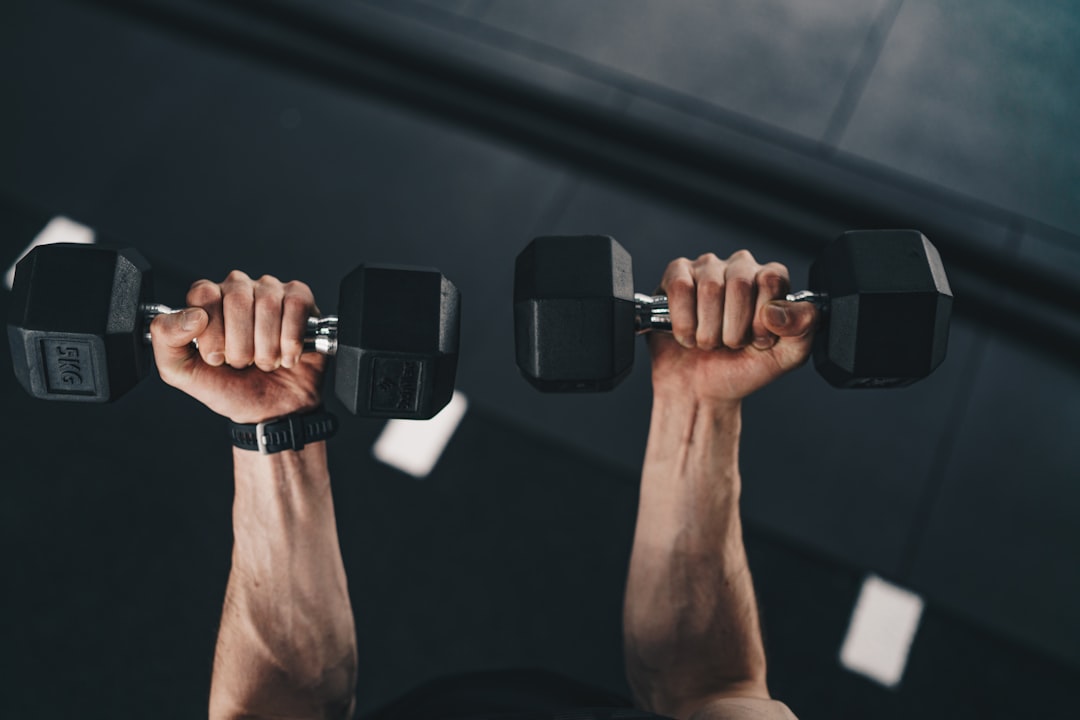
Why Building Strong Arms Is Essential for Your Daily Life
Arm exercises are foundational for upper body strength, impacting daily tasks from carrying groceries to lifting children. Targeted arm training builds muscle, improves daily function, and boosts confidence, offering benefits far beyond aesthetics.
Quick Answer for Effective Arm Exercises:
- Bicep Curls – Target biceps brachii and brachialis
- Overhead Tricep Extensions – Work all three heads of triceps
- Hammer Curls – Build biceps and forearms simultaneously
- Diamond Push-ups – Bodyweight tricep builder
- Tricep Kickbacks – Isolate triceps for definition
- Chin-ups – Compound movement for biceps and back
- Close-Grip Bench Press – Heavy tricep developer
Strong arms are crucial for functional activities and maintaining balance, especially as we age. To combat age-related muscle loss (which starts around age 35), the American College of Sports Medicine recommends strength training 2-3 days per week.
Your arms have multiple muscle groups for pushing and pulling. Biceps handle pulling, while the larger triceps muscles—making up two-thirds of your arm mass—power pushing. Training both creates balanced strength and helps prevent injury.
Consistent arm training not only builds muscle but improves overall quality of life through improved functional strength.
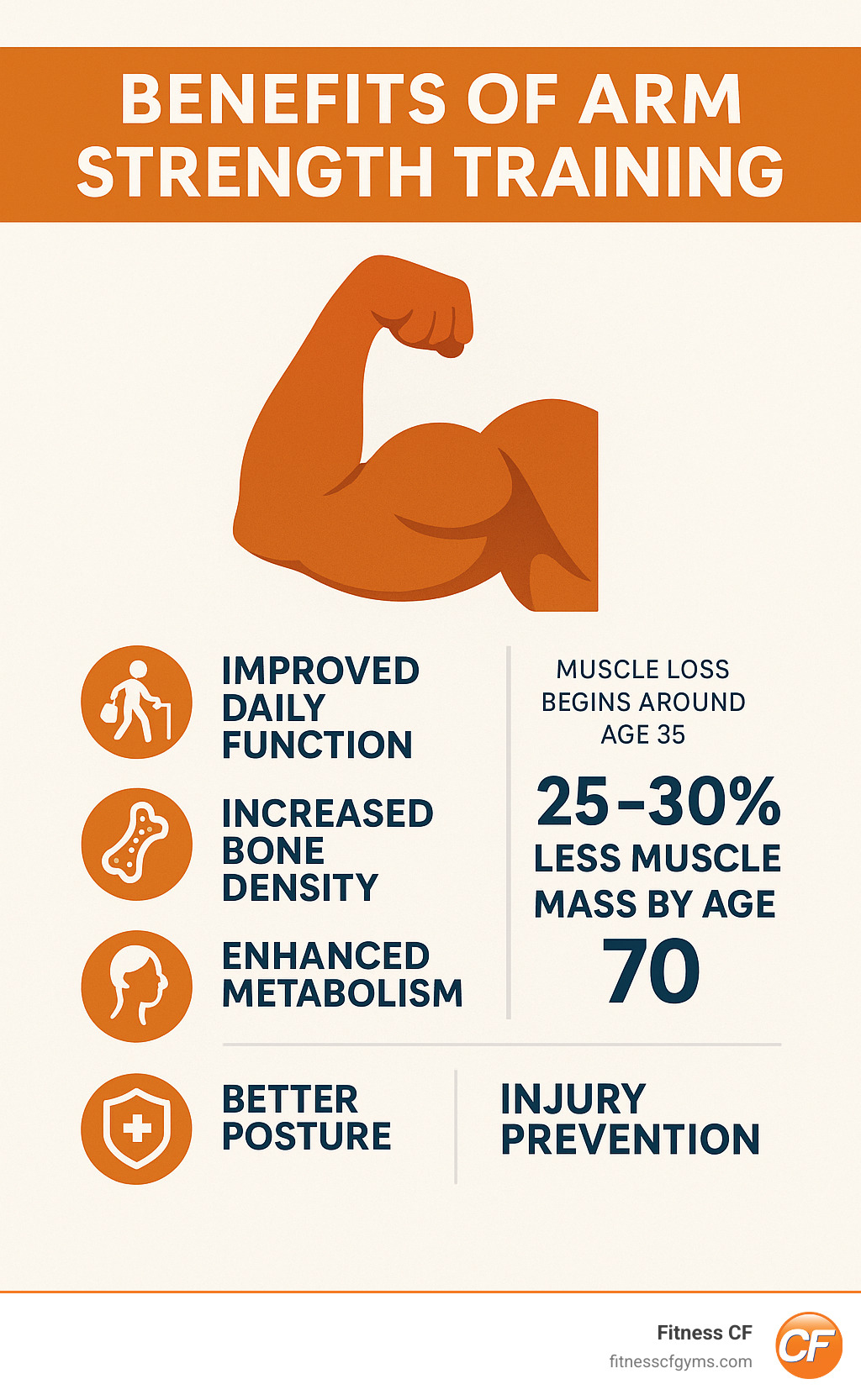
Why Strong Arms Are More Than Just for Show
While arm exercises certainly sculpt biceps and triceps, their true value lies in how they transform everyday life. Functional arm strength builds a foundation that supports everything you do. Simple tasks like carrying groceries, lifting a child, or opening a jar all rely on arm and shoulder strength. Without it, these activities can become frustrating or even lead to injury.
Consistent arm exercises improve better posture. Strong arm and shoulder muscles support your upper body, helping you stand taller and reducing neck and back pain, particularly for those with desk jobs.
Strength training also builds bone density. Arm exercises stimulate new bone growth, which is crucial for supporting bone health and preventing osteoporosis. Regular training helps counteract age-related muscle and bone loss, which begins around age 35 and accelerates after 60.
Building lean muscle through arm exercises increases metabolism. Since muscle burns more calories than fat, even at rest, this helps with weight management and improves body composition.
Developed arm muscles act as shock absorbers for your joints, reducing stress on elbows, shoulders, and wrists. This natural injury prevention system is vital for maintaining mobility as we age.
Arm strength is deeply connected to overall fitness, supporting performance in activities from swimming to hiking. It improves balance, coordination, and confidence. Learn more about What Is Strength Training and What Are Its Benefits? and Why Arm Strength Is Important for Overall Fitness.
Investing in arm exercises is about building a capable, resilient body, maintaining independence, and feeling confident in your physical abilities for years to come.
The Anatomy of Your Arms: Muscles to Target
To build impressive arms, you must understand their anatomy. Your arm muscles work as a team to create strength and power. Knowing their roles helps you choose the right arm exercises to target them effectively.
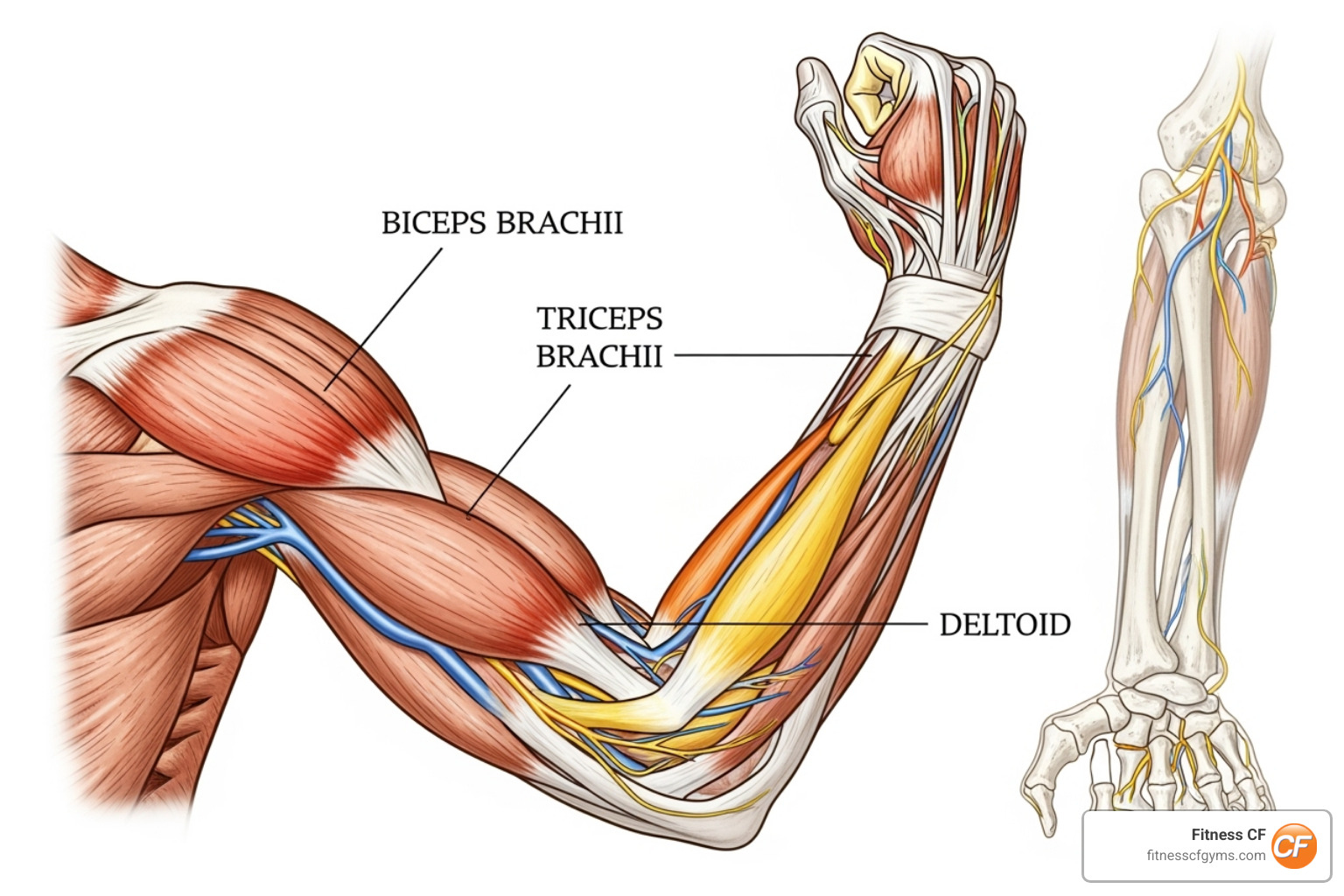
The biceps brachii, on the front of your upper arm, has two heads that work together to bend your elbow and perform pulling movements.
Beneath the biceps lies the brachialis, your strongest elbow flexor. Training it builds serious strength and adds to your arm’s peak, creating a fuller look.
The triceps brachii makes up two-thirds of your upper arm mass, making it key for size. Its three heads work to straighten your elbow, powering all pushing movements.
Your deltoids (shoulder muscles) are crucial for stability in many arm exercises, especially overhead movements. They help create a balanced, complete look.
Your forearm muscles, including the brachioradialis, are essential for grip strength. They help you hold heavy weights and perform daily tasks that require a strong grip.
For a deeper dive, see this detailed Anatomy of the upper arm resource.
The key is to understand these muscles work as a team. Biceps pull, triceps push, and forearms grip. Choosing arm exercises that target all groups from different angles ensures balanced development and prevents injuries.
7 Best Arm Exercises for Rapid Muscle Growth
These seven arm exercises are selected for their effectiveness in building muscle and functional strength. This routine includes a mix of dumbbell movements, bodyweight exercises, and compound lifts for a well-rounded approach. For more ideas, see How to Build Arm Muscle: 10 Workouts You Have to Try.
The secret to growth is proper form and controlled movements, not just heavy weight. Prioritize technique over ego. Engage your core to stabilize your body and prevent injury. Avoid swinging or using momentum; focus on a slow, controlled lift and an even slower lowering phase to maximize muscle engagement.
1. Dumbbell Bicep Curl
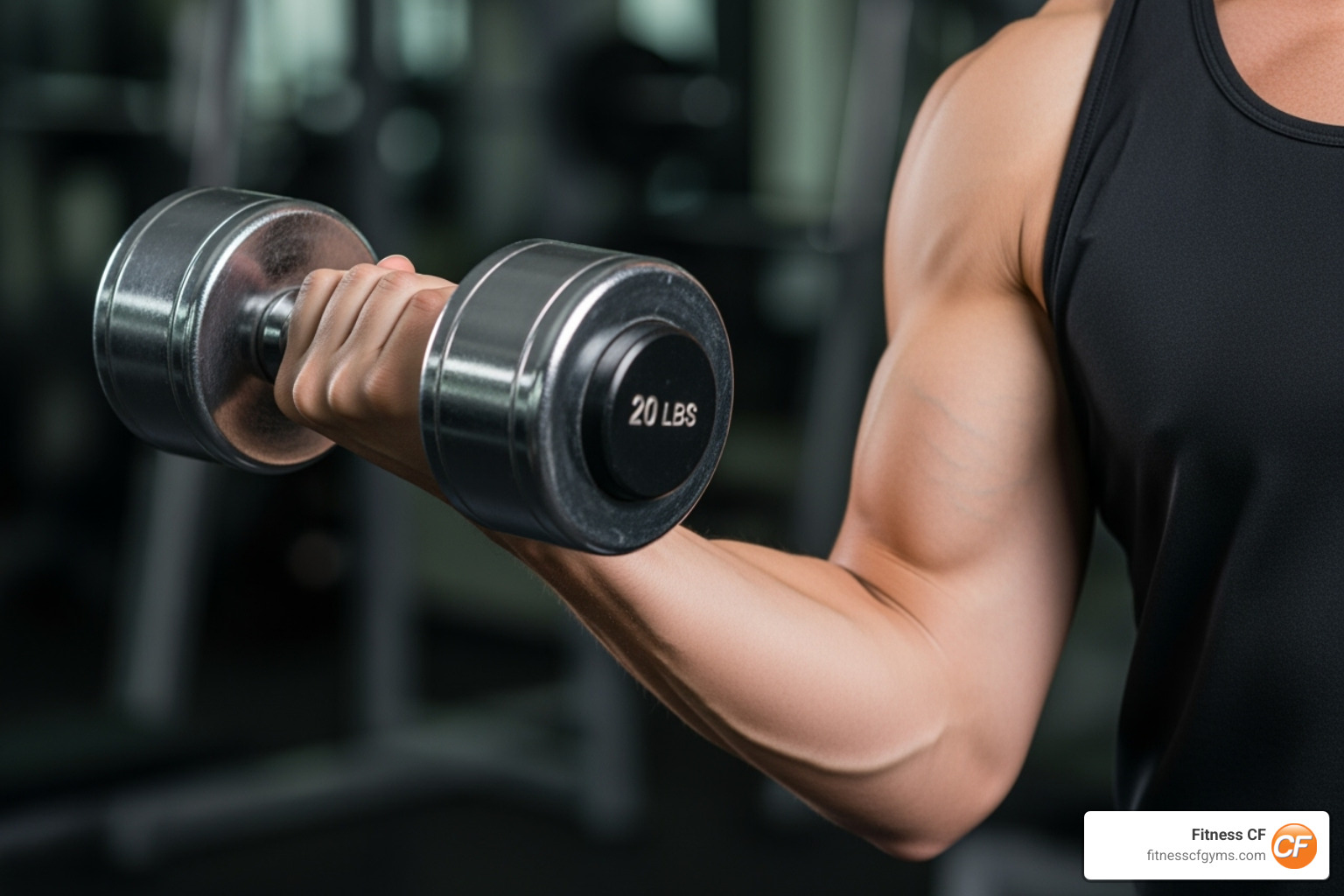
Muscles targeted: Biceps brachii, brachialis, and brachioradialis.
Technique:
Stand or sit with a dumbbell in each hand, palms facing forward. Keeping your elbows tucked to your sides, curl the weights toward your shoulders. Squeeze your biceps at the top, then slowly lower the dumbbells back to the start. Maintain control through the full range of motion.
Common mistake: Swinging the weights. If you need to use momentum, the weight is too heavy. Reduce the load and focus on form.
Reps and sets: 3 sets of 8-12 repetitions.
Equipment: Dumbbells.
2. Overhead Tricep Extension
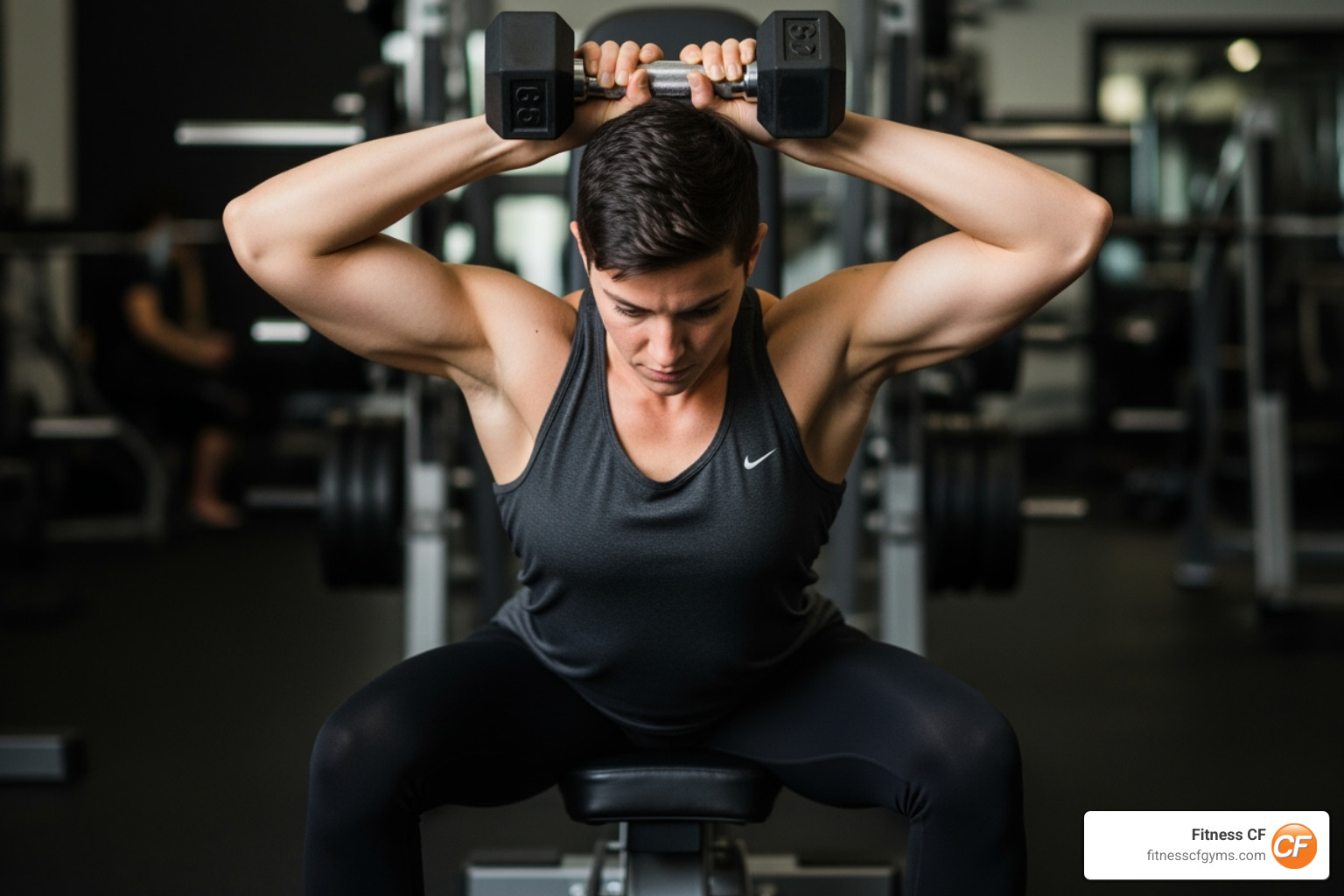
Muscles targeted: Triceps brachii (all three heads, especially the long head).
Technique:
Sit or stand holding one dumbbell with both hands. Extend your arms straight overhead. Keeping your upper arms stationary and close to your head, bend your elbows to lower the dumbbell behind you. Feel the stretch in your triceps, then extend your arms back to the start, squeezing the muscle.
Common mistake: Flaring your elbows out or arching your back. Keep your elbows pointing forward and your core tight.
Reps and sets: 3 sets of 10-15 repetitions.
Equipment: One dumbbell.
3. Hammer Curl
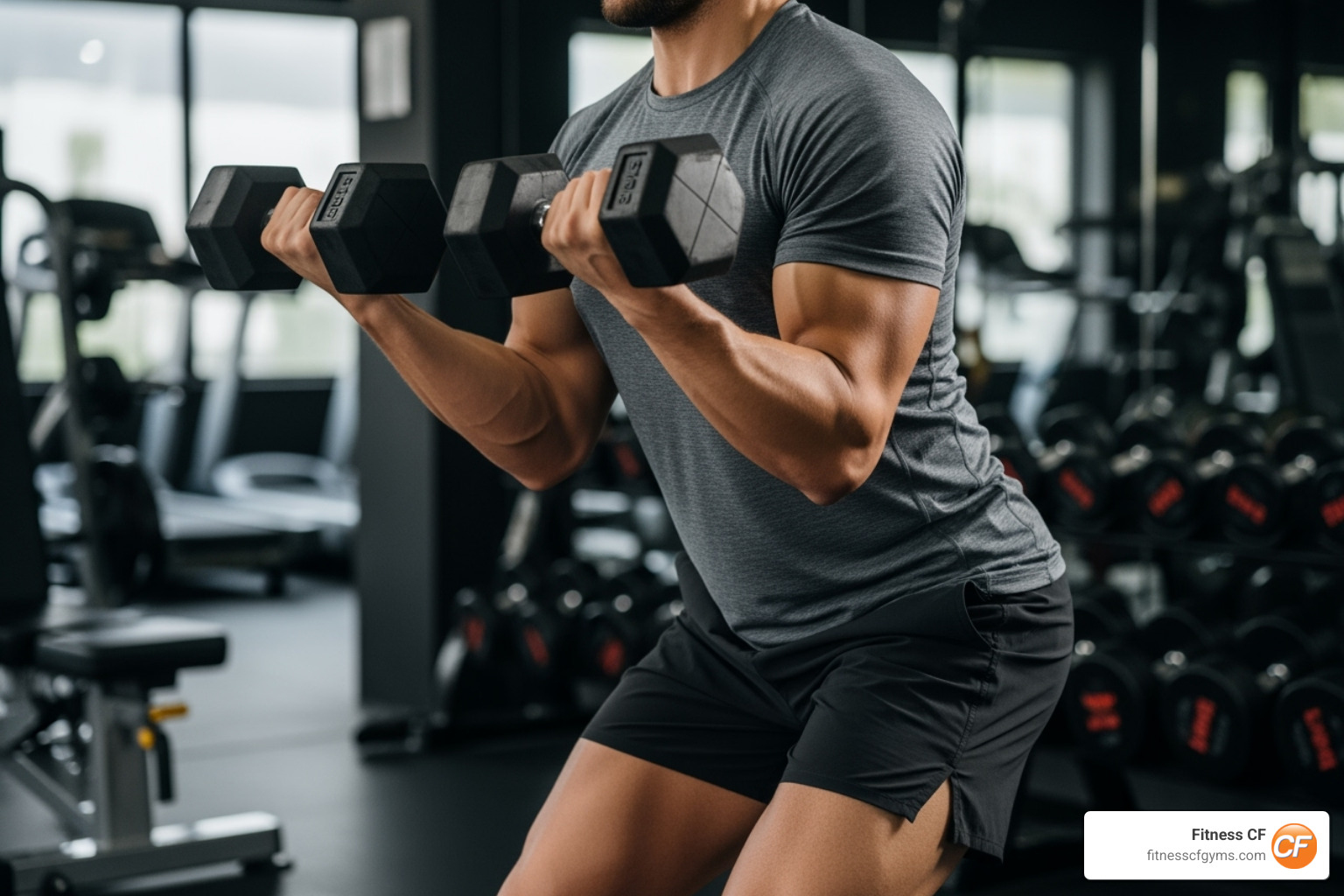
Muscles targeted: Biceps brachii, brachialis, and brachioradialis (a prominent forearm muscle).
Technique:
Hold a dumbbell in each hand with a neutral grip (palms facing your body). Keeping your elbows tucked and stationary, curl the dumbbells toward your shoulders. Squeeze at the top, then slowly lower with control.
Common mistake: Rushing the movement or bending your wrists. Keep your wrists straight and the tempo controlled.
Reps and sets: 3 sets of 8-12 repetitions.
Equipment: Dumbbells.
4. Diamond Push-Up
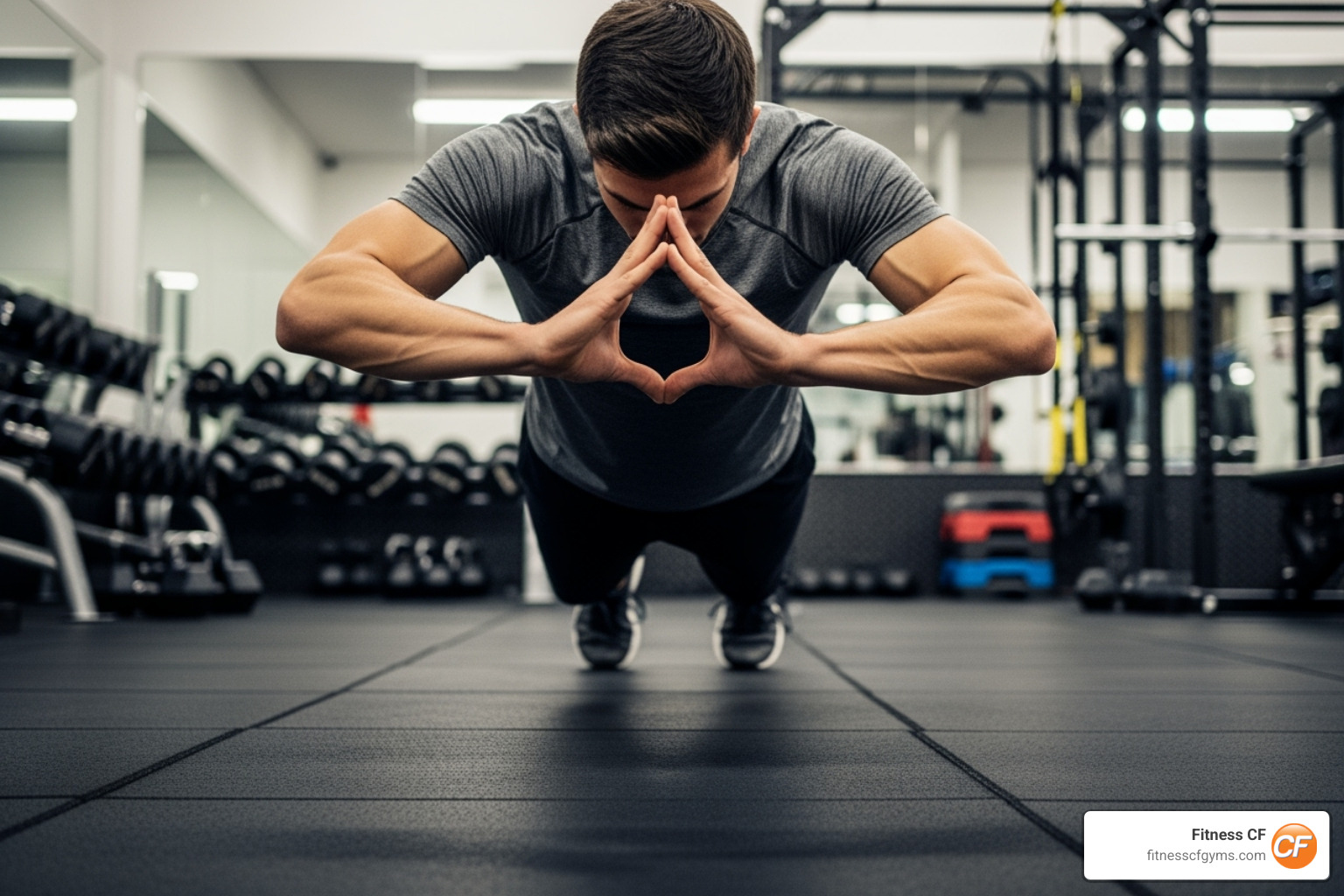
Muscles targeted: Triceps brachii, inner chest, and anterior deltoids.
Technique:
Get into a push-up position, but place your hands close together under your chest, forming a diamond shape with your thumbs and index fingers. Keeping your body in a straight line and elbows tucked close to your body, lower your chest toward your hands. Push back up powerfully, squeezing your triceps.
Common mistake: Flaring your elbows out wide. This reduces tricep activation and stresses the shoulders.
Reps and sets: 3 sets to failure. Start on your knees if needed.
Equipment: Bodyweight.
5. Tricep Kickback
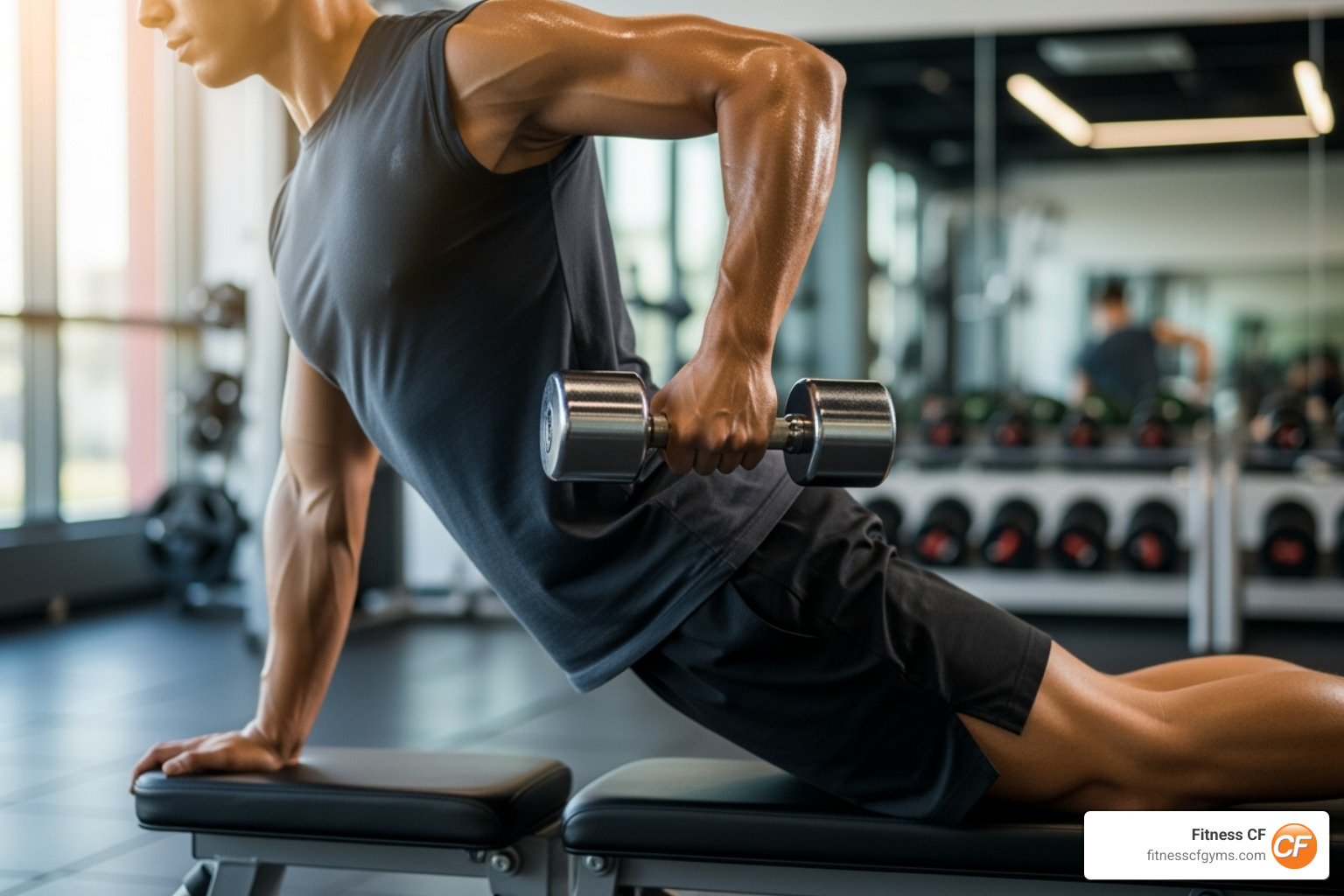
Muscles targeted: Triceps brachii (especially the lateral head).
Technique:
Hold a dumbbell in one hand and hinge at your hips, keeping your back flat and torso nearly parallel to the floor. Your upper arm should be tucked to your side and also parallel to the floor. Extend your forearm straight back until your arm is fully extended, squeezing your tricep. Return slowly to the start. Keep your upper arm completely stationary throughout.
Common mistake: Moving the entire upper arm. Use a lighter weight if this happens.
Reps and sets: 3 sets of 12-15 repetitions per arm.
Equipment: Dumbbells and a bench (optional).
6. Chin-Up
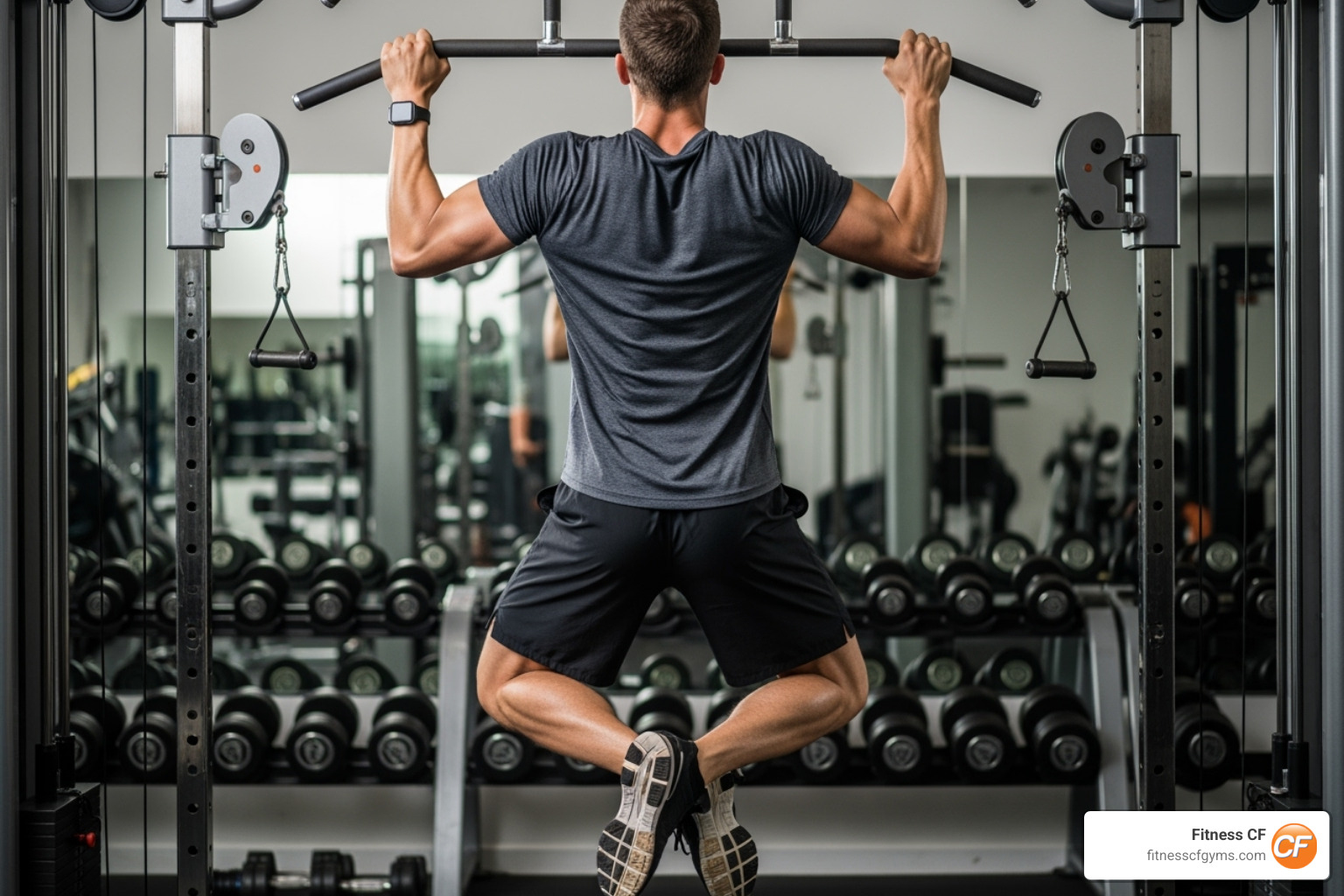
Muscles targeted: Biceps brachii and latissimus dorsi (back).
Technique:
Grab a pull-up bar with an underhand grip (palms facing you), hands shoulder-width apart. From a full hang, pull your chest toward the bar by driving your elbows down. Squeeze your biceps and back at the top. Lower yourself slowly and with control to a full extension.
Common mistake: Not using full range of motion or using momentum. Use an assisted machine or bands if you can’t do a full chin-up.
Reps and sets: 3 sets to failure.
Equipment: Pull-up bar.
7. Close-Grip Bench Press
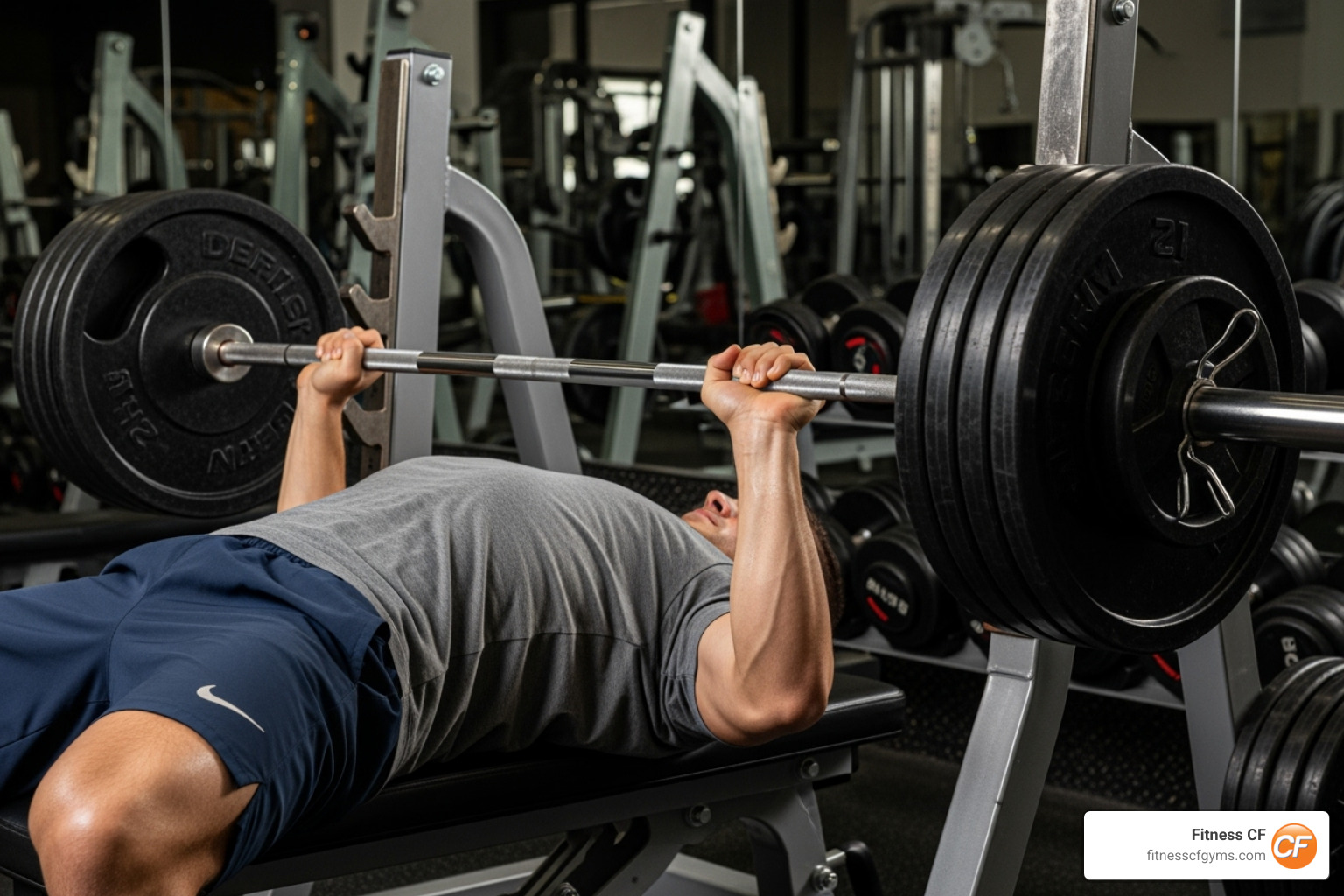
Muscles targeted: Triceps brachii, pectoralis major (chest), and anterior deltoids.
Technique:
Lie on a flat bench and grab a barbell with an overhand grip, hands about shoulder-width apart or slightly closer. Lower the bar to your lower chest, keeping your elbows tucked close to your body. Press the bar back up powerfully, fully extending your arms and squeezing your triceps at the top.
Common mistake: Flaring your elbows out wide or bouncing the bar off your chest.
Reps and sets: 3 sets of 6-10 repetitions.
Equipment: Barbell or dumbbells, and a flat bench.
How to Structure Your Arm Workouts for Optimal Results
Building impressive arms requires a smart workout structure that maximizes growth and prevents injury.
Training frequency: Aim to train arms 2-3 non-consecutive days per week. This follows ACSM strength training guidelines and research showing that training arms at least 2 days per week is optimal for muscle growth.
Rest and recovery: Muscles grow during rest, not during the workout. Allow 24 to 48 hours for recovery between arm sessions, especially if you feel muscle soreness (DOMS). Listen to your body and don’t train through significant pain.
Sets and repetitions: For muscle growth (hypertrophy), a range of 2-3 sets of 8-12 repetitions per exercise is highly effective. Choose a weight where the last few reps are challenging but possible with good form.
Progressive overload: To keep making progress, you must consistently challenge your muscles. You can do this by gradually increasing weight, reps, or sets, or by decreasing rest time between sets.
Proper warm-ups and cool-downs: Always start with a warm-up to increase blood flow and prepare your joints. A cool-down helps your heart rate return to normal and can improve flexibility. For more details, see The Importance of Warm-Up and Cool-Down Exercises: A Comprehensive Guide.
Nutrition plays a starring role: Support muscle repair and growth with adequate protein, fuel your workouts with complex carbohydrates, and stay hydrated. Proper nutrition is essential for results. Learn more from The Role of Nutrition in Fitness: What to Eat Before and After a Workout.
Avoid common pitfalls by prioritizing form over ego and being consistent. For more tips, review 11 Common Muscle Building Mistakes and How to Avoid Them.
Frequently Asked Questions about Arm Training
Here are answers to some of the most common questions about arm exercises.
How long does it take to see results from arm exercises?
Results vary based on consistency, diet, genetics, and training intensity. However, a general timeline is:
- Beginner gains: Beginners often feel stronger within the first couple of weeks.
- Noticeable visual changes: Most people see more muscle tone and definition around the 6-8 week mark.
- Significant changes: Major changes in muscle size and strength typically become apparent after 12 weeks or longer of consistent training. Consistency is the most important factor.
Can I do arm exercises every day to get faster results?
No, training arms daily is counterproductive. Muscles grow during recovery, not during the workout. Exercise creates micro-tears in muscle fibers, and they need 24-48 hours to repair and get stronger. Training sore muscles (DOMS) too soon can hinder growth and increase injury risk. The ACSM recommendation of training arms at least 2 days per week on non-consecutive days is ideal for stimulating growth while allowing for adequate recovery.
What if I don’t have dumbbells?
You don’t need dumbbells for an effective arm workout. Many alternatives work just as well:
- Bodyweight arm exercises: Diamond push-ups and tricep dips on a chair are excellent for triceps. Inchworms challenge your arms and core.
- Resistance bands: These are great for providing variable resistance. You can do bicep curls with bands by standing on the band or tricep pushdowns by anchoring it to a high point.
- Household items: Get creative! Water bottles, soup cans, or a backpack filled with books can be used for resistance in exercises like curls or overhead extensions. Your muscles respond to effort and resistance, not the type of equipment used.
Conclusion
We’ve covered the many benefits of arm exercises, from building functional strength for daily life to boosting metabolism and bone health. By understanding the anatomy of our biceps, triceps, and forearms and using proven arm exercises like dumbbell bicep curls and diamond push-ups, you can build balanced, functional strength.
Consistency and proper form are the keys to success. It’s about controlled, safe movements, not just lifting heavy weight. Combined with a smart workout structure, adequate rest, and proper nutrition, you are setting yourself up for lasting results.
Starting an arm exercise routine is an investment in your future self—one who is stronger, more confident, and capable of enjoying an active lifestyle for years to come. Strong arms are a vital part of a comprehensive approach to wellness that benefits your entire body.
Are you ready to feel stronger and move better? Start your fitness journey with us today and find the power of a consistent, well-planned fitness routine. Your future self will thank you.




